Uncategorized
ARC’s Elroy Cheo on How Asia Is Doing Web3 Differently

Elroy Cheo, co-founder and architect of influential Web3 collective ARC, is on a mission to redefine the dynamics of digital communities.
Cheo and fellow entrepreneur Kiat Lim, the son of billionaire businessman Peter Lim, have made ARC into a hub for collaboration for the global Asian diaspora, enabling members to use a Stellar NFT and a Soulbound Token called Fyrian to get access to the ARC app, as well as exclusive events and merchandise. Cheo’s vision is to build a meritocratic network rooted in shared goals and collective action.
This series is brought to you by Consensus Hong Kong. Come and experience the most influential event in Web3 and Digital Assets, Feb.18-20. Register today and save 15% with the code CoinDesk15.
Here, Cheo discusses his vision for ARC, how his background in property development and music has influenced his approach and why Asia is uniquely positioned to lead the next phase of NFT innovation. Cheo will be a speaker at Consensus Hong Kong in February.
The following interview has been edited for clarity and brevity.
How have your personal experiences shaped your approach to creating and building ARC?
My journey is a bit unconventional — I started in commodities and property development. Before crypto, my last big project was overseeing a mega-city development in China. When I first arrived, it was barren land, just fields and farmers. We bought the land, built infrastructure and now it’s a bustling city with a high GDP. That experience stuck with me — seeing how you can bring people together to create something meaningful out of nothing.
In 2016, I got into crypto thanks to my uncle — a 73-year-old software developer. We worked on a blockchain-based music copyright project to tackle siloed databases. Disputes over ownership are so common in the music industry and blockchain felt like the perfect solution to consolidate ownership records. Even today, that project’s still alive, and I’m proud it never relied on a token to survive.
That foundation as a builder shaped how I view crypto — it’s not just about investing or speculation; it’s about creating value. That led to ARC, a Web3 collective inspired by Balaji Srinivasan’s network state theory. While Srinivasan talks about these communities becoming nation-states (something we’re not doing), we are focused on building a digital-first institution driven by alignment and collective action.
The word “community” gets thrown around a lot in Web3, often losing its meaning. How does ARC create genuine connections and stay grounded in principles?
Community isn’t just about numbers or floor prices; it’s about relationships. Without bonds between members, you’re building an audience, not a community. We realized that members value four things. First, access to professional networks, which means curated connections with builders and investors. Second, opportunities to make money, such as token allocations to investments. Third, lifestyle experiences, such as meeting someone like soccer star Cristiano Ronaldo, or engaging in exclusive brand partnerships. Finally, growth, whether it’s through finding a job or receiving personal mentorship.
We also promote a “give value to receive value” ethos. This idea is drawn from the concept in Chinese culture of guanxi and emphasizes mutual support. Members aren’t just here to “ask for alpha.” They support one another.
What sets Asian Web3 communities apart from their Western counterparts?
One big difference is how vocal Western communities are. They dominate crypto Twitter, while Asians tend to be more reserved. Culturally, platforms like Twitter aren’t as widely used here — Chinese users, for instance, are more active in private WeChat or Telegram groups.
Despite that, Asian liquidity is massive. A small Chinese community can drive $1 billion in DeFi protocol TVL in a day, which is rare in the West. At ARC, we recognize this strength but also encourage members to engage more publicly. Asia is a Web3 powerhouse, and it’s time we capture mindshare, not just liquidity.
How do NFTs evolve, especially with respect to digital identity and utility?
The shift toward pseudonymity excites me. People are moving from polished profiles on Facebook or LinkedIn to avatars. It’s empowering — kids can hide behind a PFP, yet their skills and knowledge shine through. At ARC, we’re exploring NFTs as status symbols. Imagine walking into a hotel or event, and your NFT gives you instant recognition. Beyond collectibles, NFTs can represent expertise or achievements, like badges on Stack Overflow. It’s about creating digital identities with real-world impact.
With ARC’s membership capped at 888, how can the organization’s exclusivity and status-driven model continue to scale?
Exclusivity works when it’s tied to brand value and proper community management. We’ve kept ARC small — 888 members — because it allows us to focus on quality over quantity. But scaling is possible with the right frameworks. Look at Reddit: one community manager oversaw millions of users by leveraging guidelines and moderation tools.
The key is maintaining brand prestige. For example, we partnered with the luxury boutique chain Edition Hotel before the opening of its Singapore location. When I asked their director why they gave us special treatment like exclusive hospitality rates to our members, he said, “You’re ARC.” That’s the power of brand equity. It’s about scarcity, reputation and delivering consistent value. Also, ARC uses contributor systems to incentivize active participation. For example, top contributors get access to deals, events and unique experiences, ensuring that value flows to those who add to the community.
What misconceptions do you see about NFTs, particularly in Asia?
One common mistake is viewing NFTs purely as revenue streams. Many Asian IPs and brands still approach NFTs as transactional rather than as tools for community building. I believe NFTs can move beyond speculation to foster community-driven growth. For example, imagine a boba shop using NFTs to transition customers into members. Instead of a traditional marketing funnel, the NFT creates a non-linear experience where members stay engaged and help promote the brand organically. It’s about creating advocates, not just customers.
What excites you about Web3 innovation in Asia right now?
Talent. Asia is brimming with brilliant developers — Vietnamese, Chinese, Singaporean. The challenge is internationalizing their projects because of language barriers. But as infrastructure improves, I believe Asia will cement itself as a leader in the space. AI is another exciting frontier. Overall, I’m thrilled to see Southeast Asia leading innovation in DeFi and NFTs.
Having launched during a bear market in January 2022, what advice do you have for builders in the Web3 space?
Build with passion. Narratives in crypto change quickly, and without passion, it’s easy to give up. A lot of founders burn out because they lose sight of their purpose. My advice: stay hungry, stay curious and treat your projects as social experiments. Rapid execution with clear goals is key.
Lastly, what are you most excited to share on-stage in HK?
I’d love to talk about what I know best — using NFTs to build communities. NFTs are a great way to create a brand, a culture and a strong community. Then, down the line, a fungible token can coordinate those members toward a shared goal. It’s about starting with a community-first approach, which I call a Web3 social product.
At ARC, we’re trying to build a digital-first institution with a highly aligned community. This concept of digital communities has only really flourished post-COVID, thanks to tools like Zoom and Google Meet bringing people together online.
Uncategorized
AI, Mining News: GPU Gold Rush: Why Bitcoin Miners Are Powering AI’s Expansion

When Core Scientific signed a $3.5 billion deal to host artificial intelligence (AI) data centers earlier this year, it wasn’t chasing the next crypto token — it was chasing a steadier paycheck. Once known for its vast fleets of bitcoin mining rigs, the company is now part of a growing trend: converting energy-intensive mining operations into high-performance AI facilities.
Bitcoin miners like Core, Hut 8 (HUT) and TeraWulf (WULF) are swapping ASIC machines — the dedicated bitcoin mining computer — for GPU clusters, driven by the lure of AI’s explosive growth and the harsh economics of crypto mining.
Power play
It’s no secret that bitcoin mining requires an extensive amount of energy, which is the biggest cost of minting a new digital asset.
Back in the 2021 bull run, when the Bitcoin network’s hashrate and difficulty were low, miners were making out like bandits with margins as much as 90%. Then came the brutal crypto winter and the halving event, which slashed the mining reward in half. In 2025, with surging hashrate and energy prices, miners are now struggling to survive with razor-thin margins.
However, the need for power—the biggest input cost—became a blessing in disguise for these miners, who needed a different strategy to diversify their revenue sources.
Due to rising competition for mining, the miners continued to procure more machines to stay afloat, and with it came the need for more megawatts of electricity at a cheaper price. Miners invested heavily in securing these low-cost energy sources, such as hydroelectric or stranded natural gas sites, and developed expertise in managing high-density cooling and electrical systems—skills honed during the crypto boom of the early 2020s.
This is what captured the attention of AI and cloud computing firms. While bitcoin relies on specialized ASICs, AI thrives on versatile GPUs like Nvidia’s H100 series, which require similar high-power environments but for parallel processing tasks in machine learning. Instead of building out data centers from scratch, taking over mining infrastructure, which already has power ready, became a faster way to grow an increasing appetite for AI-related infrastructure.
Essentially, these miners aren’t just pivoting—they’re retrofitting.
The cooling systems, low-cost energy contracts, and power-dense infrastructure they built during the crypto boom now serve a new purpose: feeding the AI models of companies like OpenAI and Google.
Firms like Crusoe Energy sold off mining assets to focus solely on AI, deploying GPU clusters in remote, energy-rich locations that mirror the decentralized ethos of crypto but now fuel centralized AI hyperscalers.
Terraforming AI
Bitcoin mining has effectively «terraformed» the terrain for AI compute by building out scalable, power-efficient infrastructure that AI desperately needs.
As Nicholas Gregory, Board Director at Fragrant Prosperity, noted, «It can be argued bitcoin paved the way for digital dollar payments as can be seen with USDT/Tether. It also looks like bitcoin terraformed data centres for AI/GPU compute.»
This pre-existing «terraforming» allows miners to retrofit facilities quickly, often in under a year, compared to the multi-year timelines for traditional data center builds. Firms like Crusoe Energy sold off mining assets to focus solely on AI, deploying GPU clusters in remote, energy-rich locations that mirror the decentralized ethos of crypto but now fuel centralized AI hyperscalers.
Higher returns
In practice, it means miners can flip a facility in less than a year—far faster than the multi-year timeline of a new data center.
But AI isn’t a cheap upgrade.
Bitcoin mining setups are relatively modest, with costs ranging from $300,000 to $800,000 per megawatt (MW) excluding ASICs, allowing for quick scalability in response to market cycles. Meanwhile, AI infrastructure demands significantly higher capex due to the need for advanced liquid cooling, redundant power systems, and the GPUs themselves, which can cost tens of thousands per unit and face global supply shortages. Despite the steeper upfront costs, AI offers miners up to 25 times more revenue per kilowatt-hour than bitcoin mining, making the pivot economically compelling amid rising energy prices and declining crypto profitability.
A niche industry worth billions
As AI continues to surge and crypto profits tighten, bitcoin mining could become a niche game—one reserved for energy-rich regions or highly efficient players, especially as the next in 2028 could render many operations unprofitable without breakthroughs in efficiency or energy costs.
While projections show the global crypto mining market growing to $3.3 billion by 2030, at a modest 6.9% CAGR, the billions would be overshadowed by AI’s exponential expansion. According to KBV Research, the global AI in mining market is projected to reach $435.94 billion by 2032, expanding at a compound annual growth rate (CAGR) of 40.6%.
With investors already seeing dollar signs in this shift, the broader trend suggests the future is either a hybrid or a full conversion to AI, where stable contracts with hyperscalers promise longevity over crypto’s boom-bust cycles.
This evolution not only repurposes idle assets but also underscores how yesterday’s crypto frontiers are forging tomorrow’s AI empires.
Uncategorized
Bitcoin Climbs as Economy Cracks — Is it Bullish or Bearish?

Bitcoin (BTC) is about 4% higher than it was a week ago—good news for the digital asset but bad news for the economy.
The recent negative tone of the economic data points from last week raised expectations that the Federal Reserve will cut interest rates on Wednesday, making riskier assets such as stocks and bitcoin more attractive.
Let’s recap the data that backs up that thesis.
The most important one, the U.S. CPI figures, came out on Thursday. The headline rate was slightly higher than expected, a sign inflation might be stickier than anticipated.
Before that, we had Tuesday’s revisions to job data. The world’s largest economy created almost 1 million fewer jobs than reported in the year ended March, the largest downward revision in the country’s history.
The figures followed the much-watched monthly jobs report, which was released the previous Friday. The U.S. added just 22,000 jobs in August, with unemployment rising to 4.3%, the Bureau of Labor Statistics said. Initial jobless claims rose 27,000 to 263,000 — the highest since October 2021.
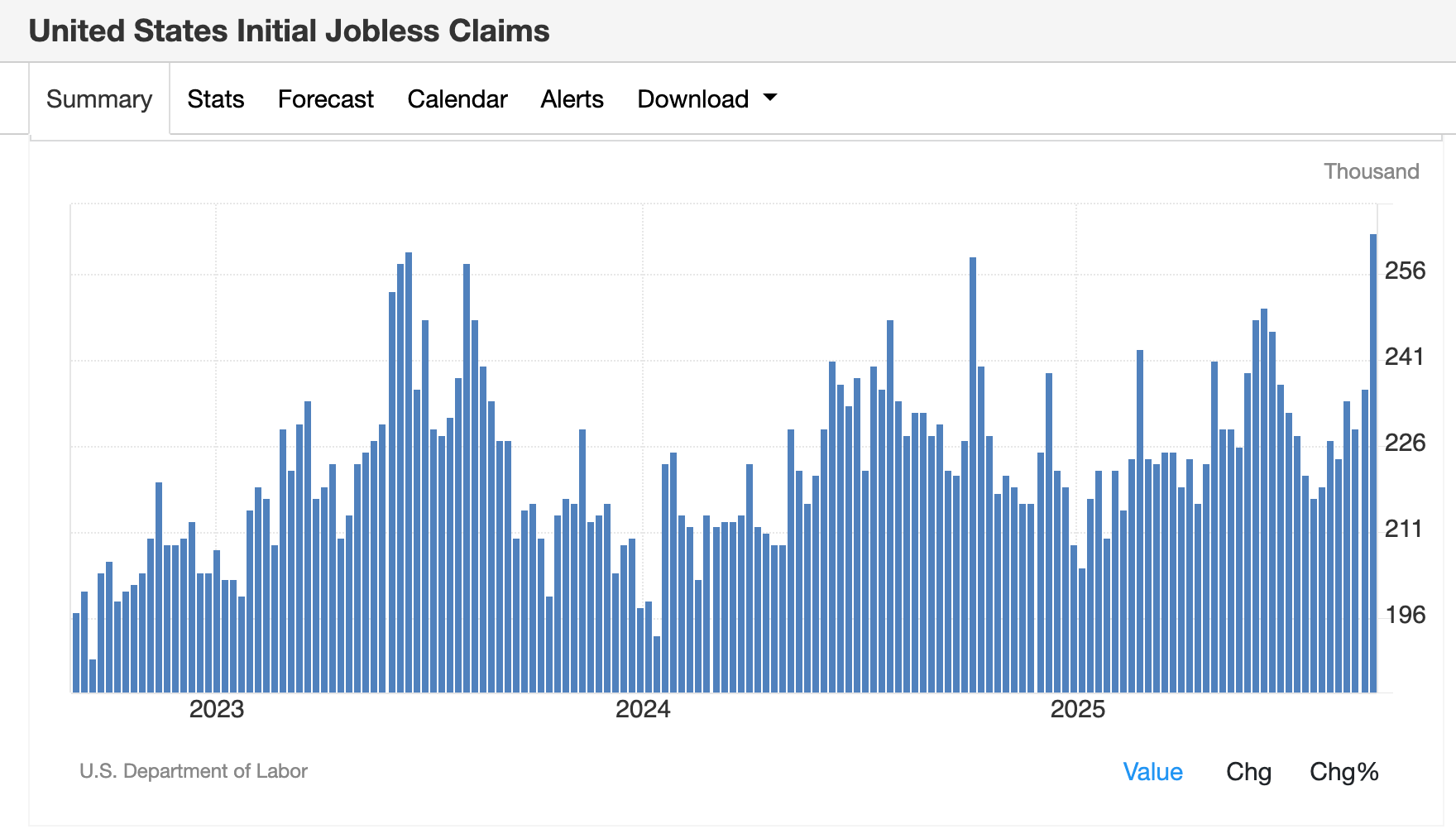
Higher inflation and fewer jobs are not great for the U.S. economy, so it’s no surprise that the word «stagflation» is starting to creep back into macroeconomic commentary.
Against this backdrop, bitcoin—considered a risk asset by Wall Street—continued grinding higher, topping $116,000 on Friday and almost closing the CME futures gap at 117,300 from August.
Not a surprise, as traders are also bidding up the biggest risk assets: equities. Just take a look at the S&P 500 index, which closed at a record for the second day on the hope of a rate cut.
So how should traders think about BTC’s price chart?
To this chart enthusiast, price action remains constructive, with higher lows forming from the September bottom of $107,500. The 200-day moving average has climbed to $102,083, while the Short-Term Holder Realized Price — often used as support in bull markets — rose to a record $109,668.
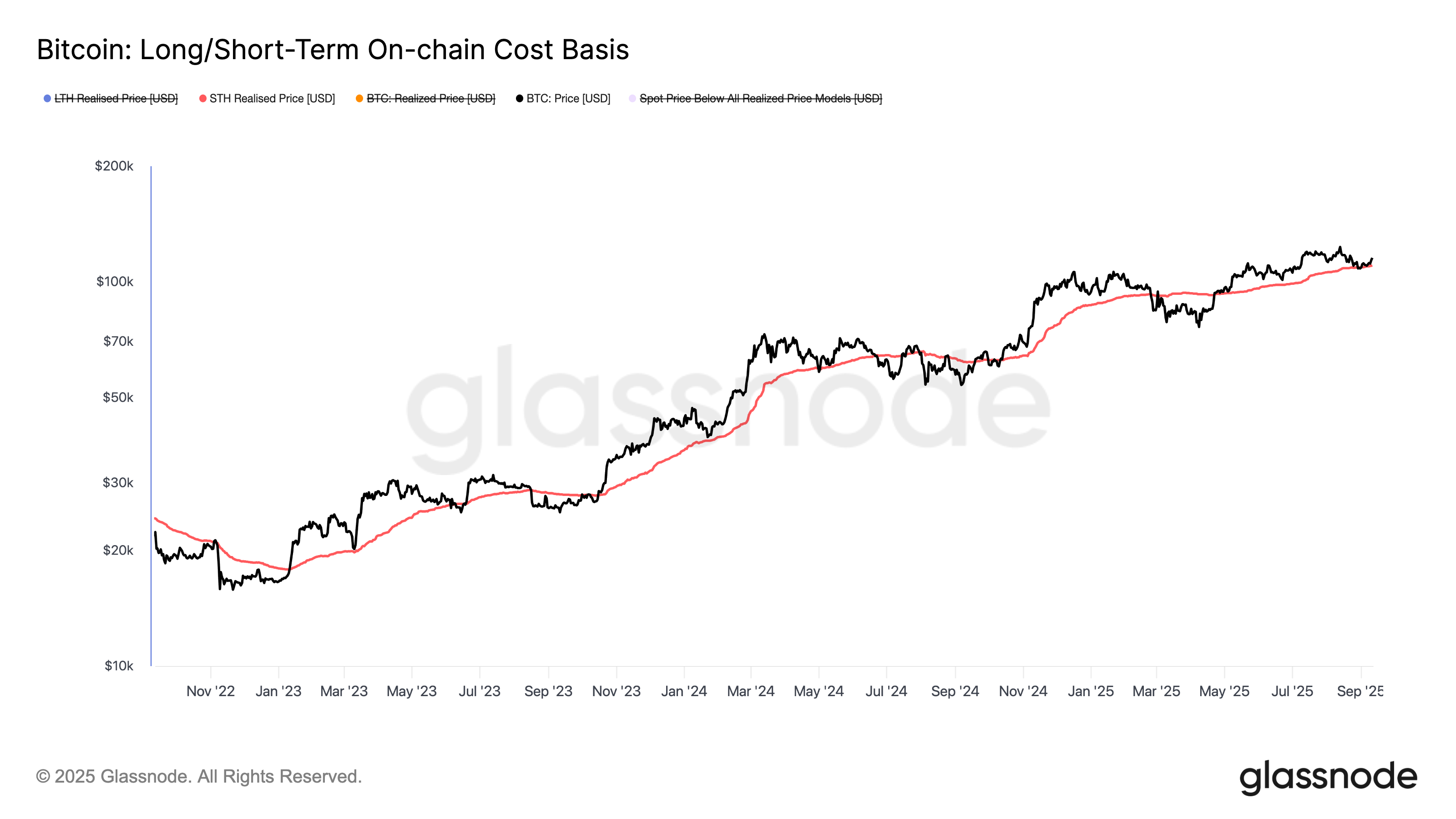
Bitcoin-linked stocks: A mixed bag
However, bitcoin’s weekly positive price action didn’t help Strategy (MSTR), the largest of the bitcoin treasury companies, whose shares were about flat for the week. Its rivals performed better: MARA Holdings (MARA) 7% and XXI (CEP) 4%.
Strategy (MSTR) has underperformed bitcoin year-to-date and continues to hover below its 200-day moving average, currently $355. At Thursday’s close of $326, it’s testing a key long-term support level seen back in September 2024 and April 2025.
The company’s mNAV premium has compressed to below 1.5x when accounting for outstanding convertible debt and preferred stock, or roughly 1.3x based solely on equity value.
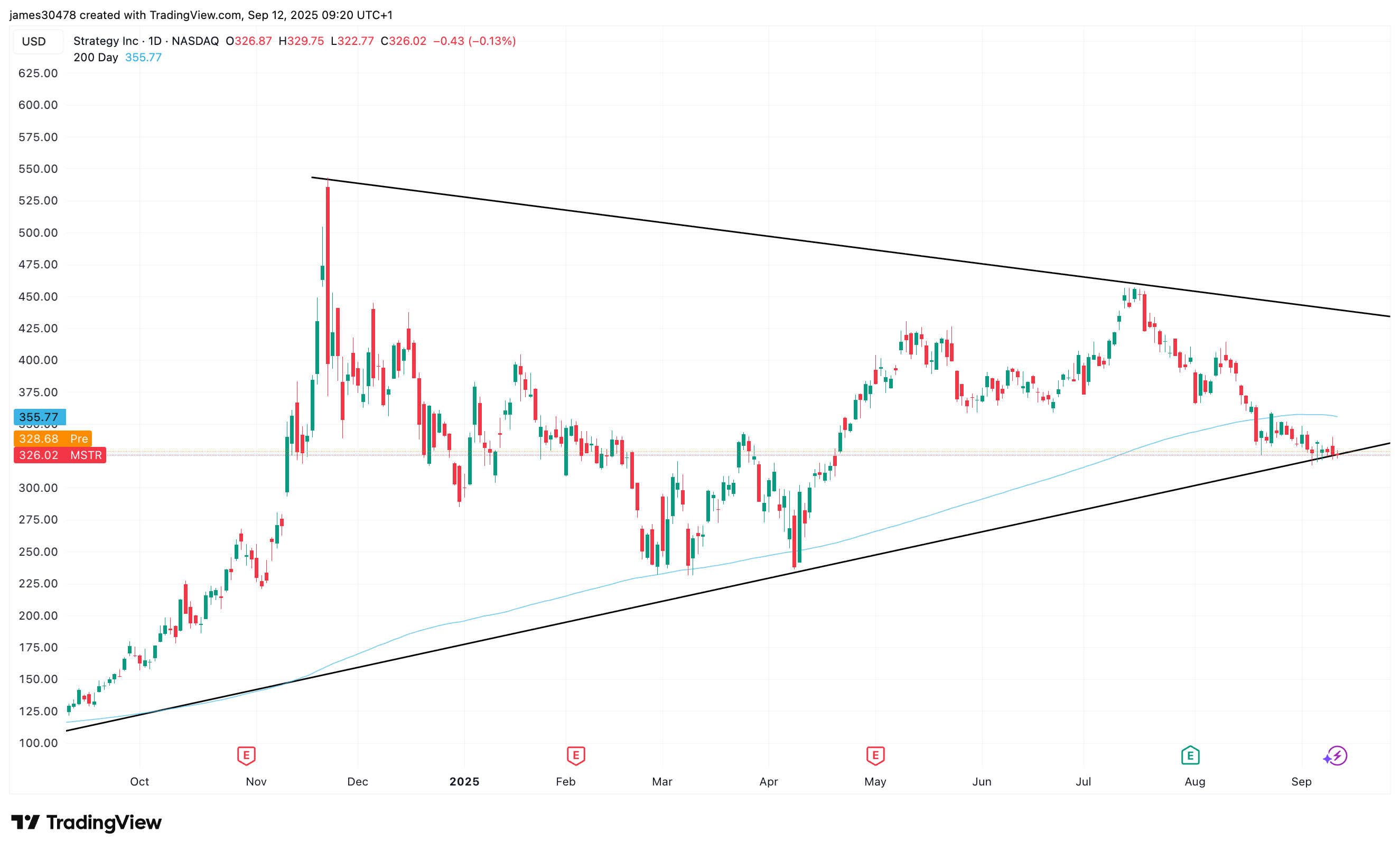
Preferred stock issuance remains muted, with only $17 million tapped across STRK and STRF this week, meaning that the bulk of at-the-money issuance is still flowing through common shares. According to the company, options are now listed and trading for all four perpetual preferred stocks, a development that could provide additional yield on the dividend.
Bullish catalysts for crypto stocks?
The CME’s FedWatch tool shows traders expect a 25 basis-point U.S. interest-rate cut in September and have priced in a total of three rate cuts by year-end.
That’s a sign risk sentiment could tilt back toward growth and crypto-linked equities, underlined by the 10-year U.S. Treasury briefly breaking below 4% this week.
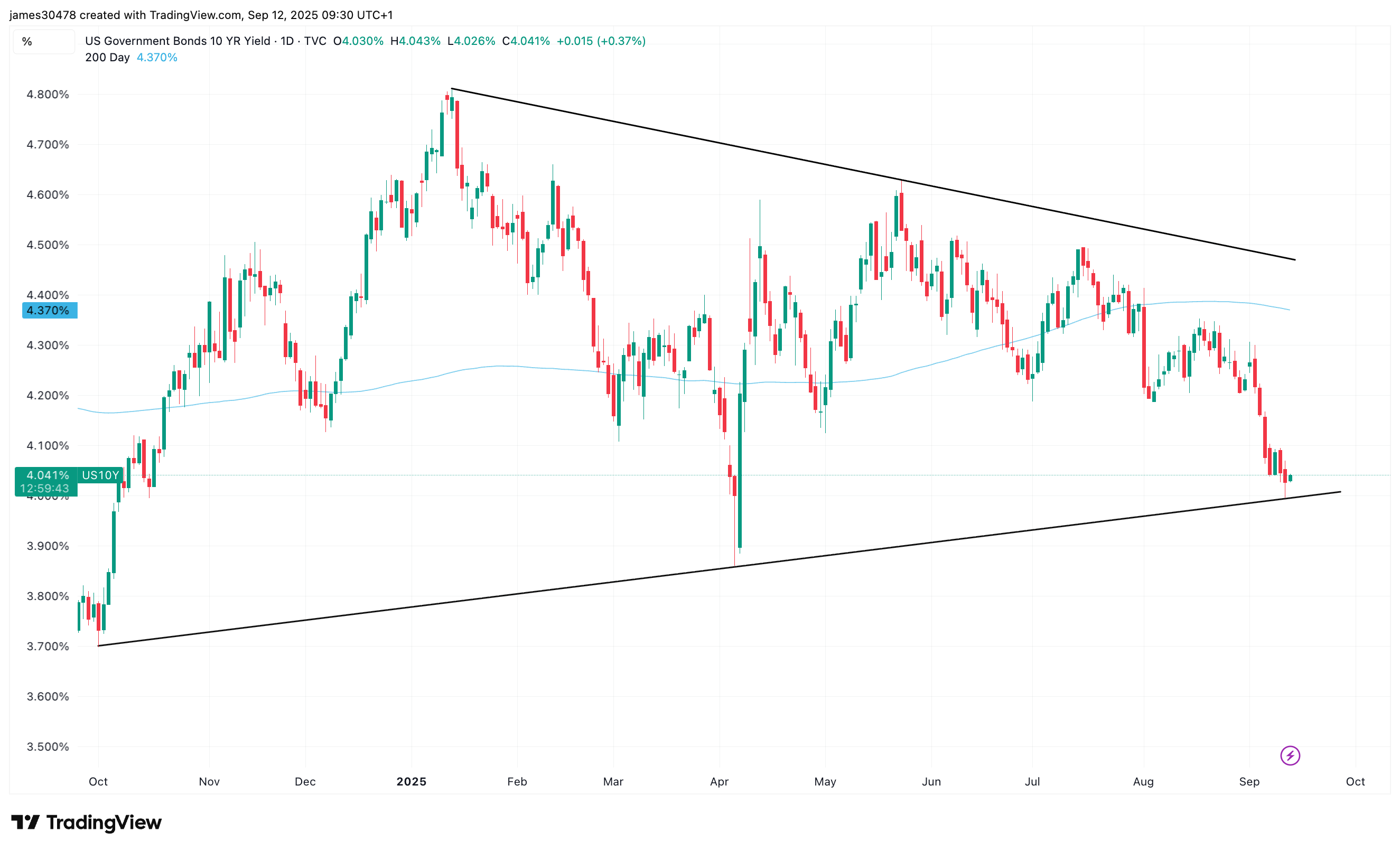
Still, the dollar index (DXY) continues to hold multiyear support, a potential inflection point worth watching.
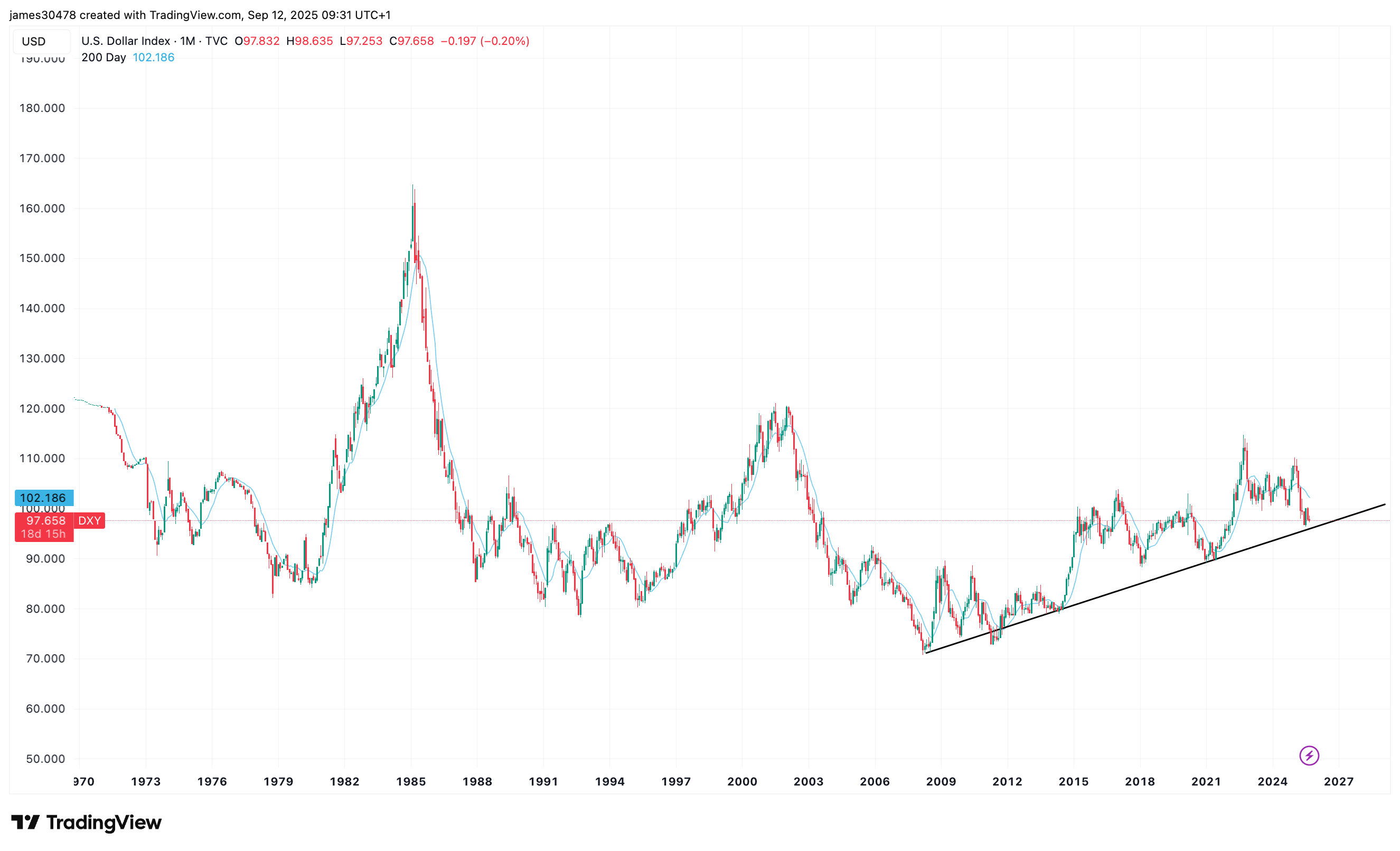
Uncategorized
Fed’s Sept. 17 Rate Cut Could Spark Short-Term Jitters but Supercharge Bitcoin, Gold and Stocks Long Term
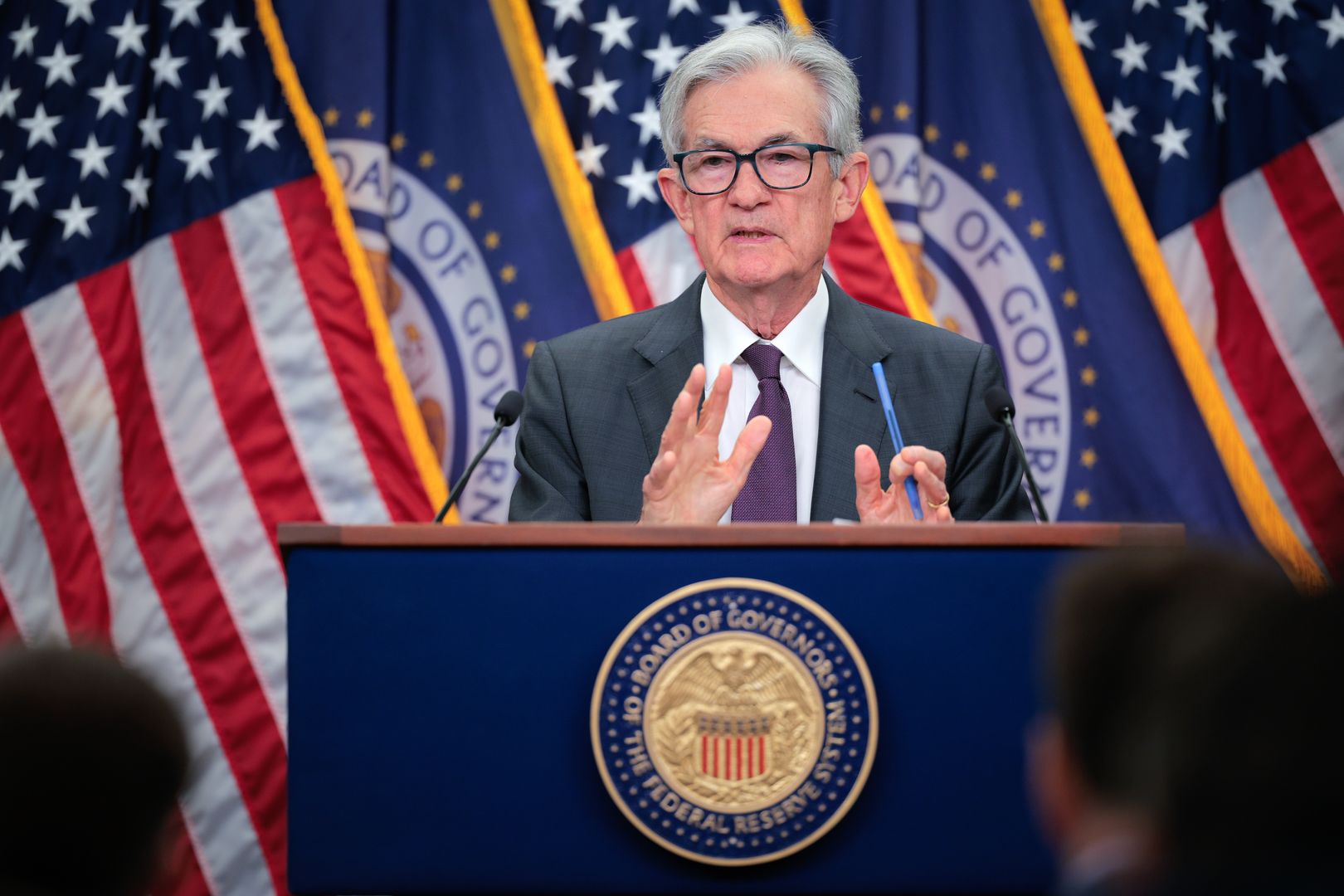
Investors are counting down to the Federal Reserve’s Sept. 17 meeting, where markets expect a quarter-point rate cut that could trigger short-term volatility but potentially fuel longer-term gains across risk assets.
The economic backdrop highlights the Fed’s delicate balancing act.
According to the latest CPI report released by the U.S. Bureau of Labor Statistics on Thursday, consumer prices rose 0.4% in August, lifting the annual CPI rate to 2.9% from 2.7% in July, as shelter, food, and gasoline pushed costs higher. Core CPI also climbed 0.3%, extending its steady pace of recent months.
Producer prices told a similar story: per the latest PPI report released on Wednesday, the headline PPI index slipped 0.1% in August but remained 2.6% higher than a year earlier, while core PPI advanced 2.8%, the largest yearly increase since March. Together, the reports underscore stubborn inflationary pressure even as growth slows.
The labor market has softened further.
Nonfarm payrolls increased by just 22,000 in August, with federal government and energy sector job losses offsetting modest gains in health care. Unemployment held at 4.3%, while labor force participation remained stuck at 62.3%.
Revisions showed June and July job growth was weaker than initially reported, reinforcing signs of cooling momentum. Average hourly earnings still rose 3.7% year over year, keeping wage pressures alive.
Bond markets have adjusted accordingly. The 2-year Treasury yield sits at 3.56%, while the 10-year is at 4.07%, leaving the curve modestly inverted. Futures traders see a 93% chance of a 25 basis point cut, according to CME FedWatch.
If the Fed limits its move to just 25 bps, investors may react with a “buy the rumor, sell the news” response, since markets have already priced in relief.
Equities are testing record levels.
Equities are testing record levels. The S&P 500 closed Friday at 6,584 after rising 1.6% for the week, its best since early August. The index’s one-month chart shows a strong rebound from its late-August pullback, underscoring bullish sentiment heading into Fed week.
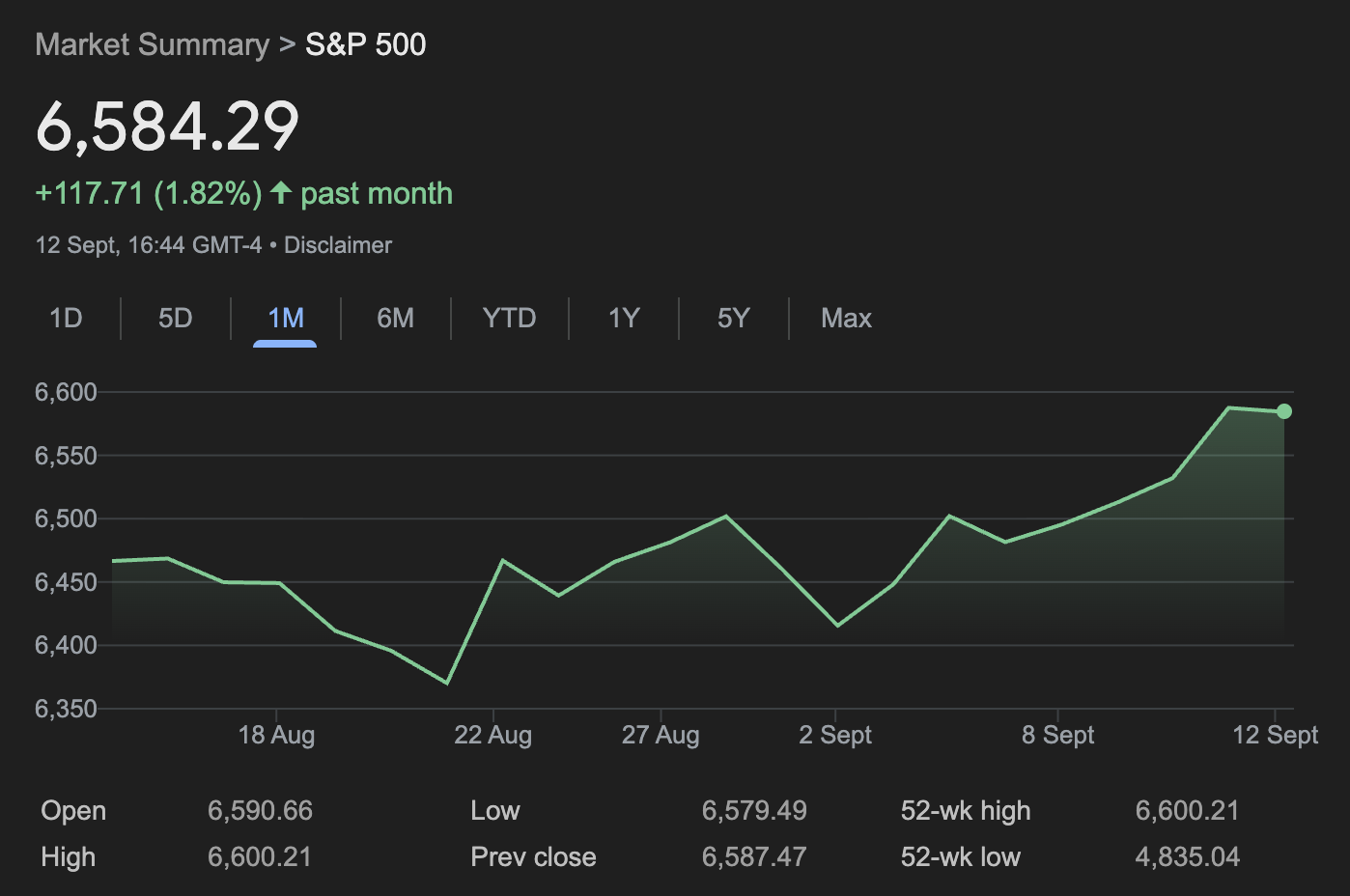
The Nasdaq Composite also notched five straight record highs, ending at 22,141, powered by gains in megacap tech stocks, while the Dow slipped below 46,000 but still booked a weekly advance.
Crypto and commodities have rallied alongside.
Bitcoin is trading at $115,234, below its Aug. 14 all-time high near $124,000 but still firmly higher in 2025, with the global crypto market cap now $4.14 trillion.
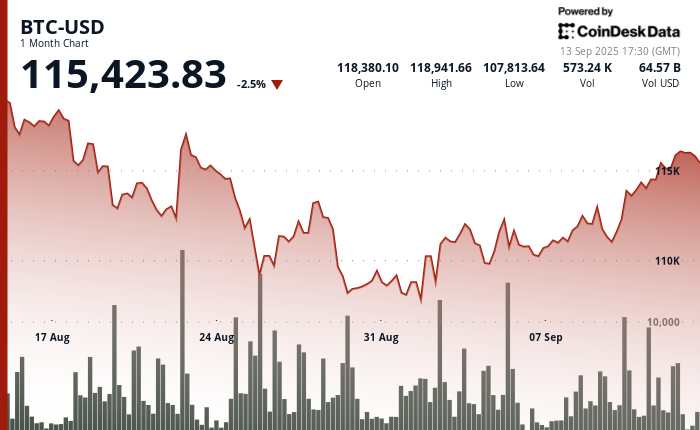
Gold has surged to $3,643 per ounce, near record highs, with its one-month chart showing a steady upward trajectory as investors price in lower real yields and seek inflation hedges.
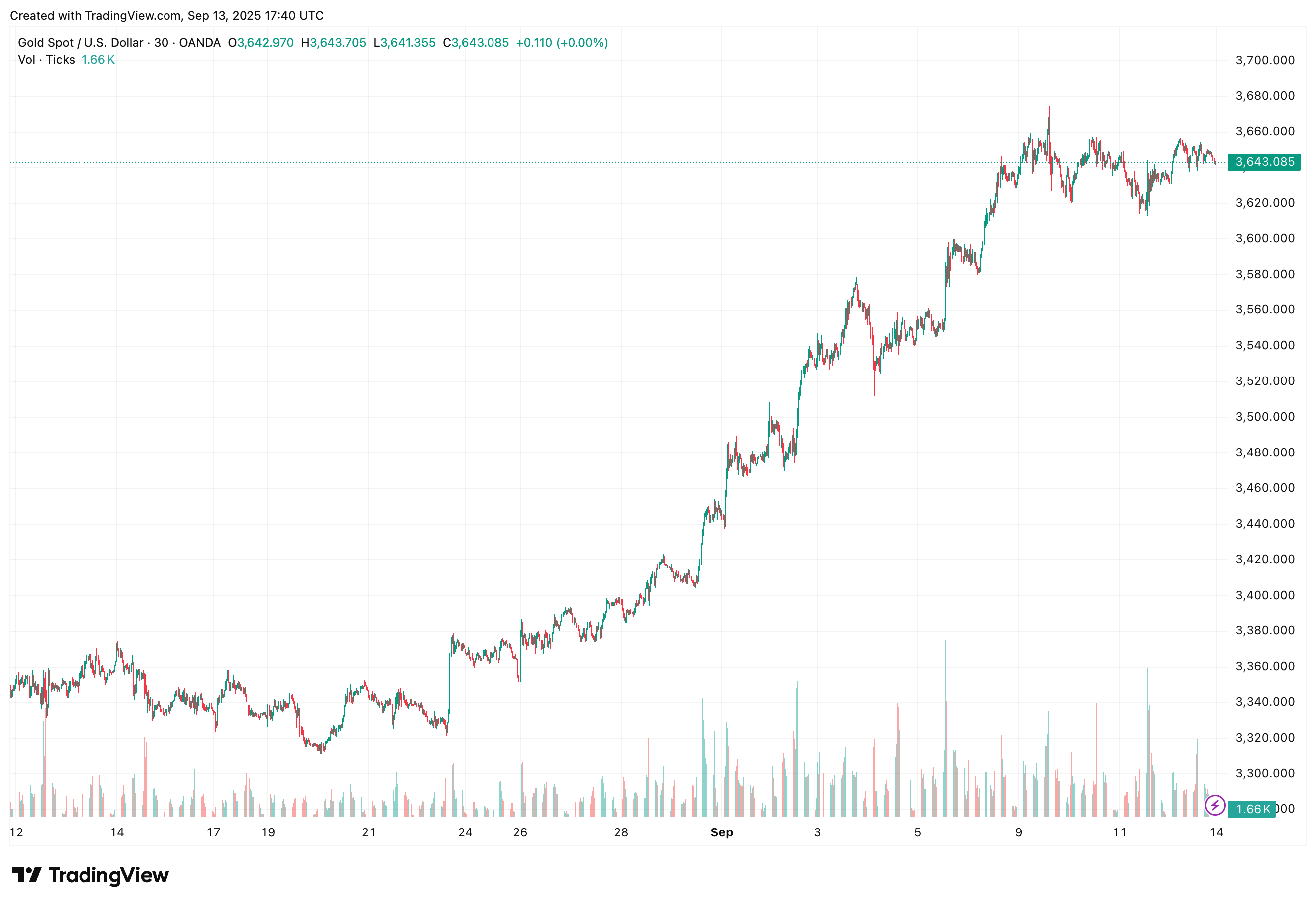
Gold has climbed steadily toward record highs, while bitcoin has consolidated below its August peak, reflecting ongoing demand for alternative stores of value.
Historical precedent supports the cautious optimism.
Analysis from the Kobeissi Letter — reported in an X thread posted Saturday — citing Carson Research, shows that in 20 of 20 prior cases since 1980 where the Fed cut rates within 2% of S&P 500 all-time highs, the index was higher one year later, averaging gains of nearly 14%.
The shorter term is less predictable: in 11 of those 22 instances, stocks fell in the month following the cut. Kobeissi argues this time could follow a similar pattern — initial turbulence followed by longer-term gains as rate relief amplifies the momentum behind assets like equities, bitcoin, and gold.
The broader setup explains why traders are watching the Sept. 17 announcement closely.
Cutting rates while inflation edges higher and stocks hover at records risks denting credibility, yet staying on hold could spook markets that have already priced in easing. Either way, the Fed’s message on growth, inflation, and its policy outlook will likely shape the trajectory of markets for months to come.
-

 Business11 месяцев ago
Business11 месяцев ago3 Ways to make your business presentation more relatable
-

 Fashion11 месяцев ago
Fashion11 месяцев agoAccording to Dior Couture, this taboo fashion accessory is back
-

 Entertainment11 месяцев ago
Entertainment11 месяцев ago10 Artists who retired from music and made a comeback
-

 Entertainment11 месяцев ago
Entertainment11 месяцев ago\’Better Call Saul\’ has been renewed for a fourth season
-

 Entertainment11 месяцев ago
Entertainment11 месяцев agoNew Season 8 Walking Dead trailer flashes forward in time
-

 Business11 месяцев ago
Business11 месяцев ago15 Habits that could be hurting your business relationships
-

 Entertainment11 месяцев ago
Entertainment11 месяцев agoMeet Superman\’s grandfather in new trailer for Krypton
-

 Entertainment11 месяцев ago
Entertainment11 месяцев agoDisney\’s live-action Aladdin finally finds its stars





